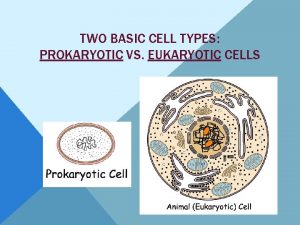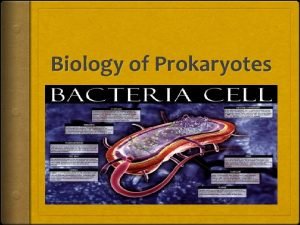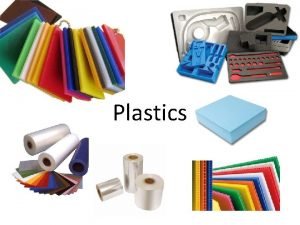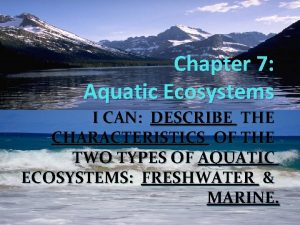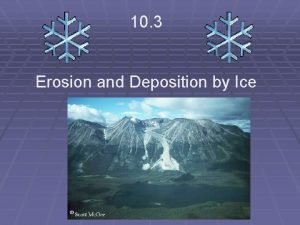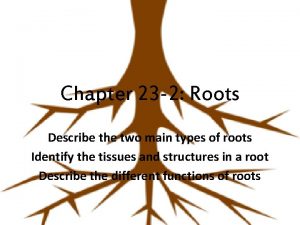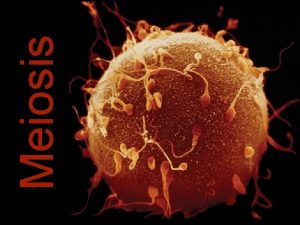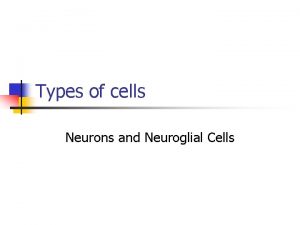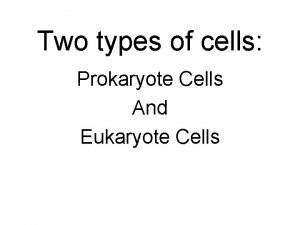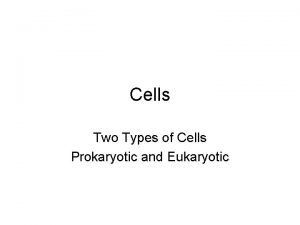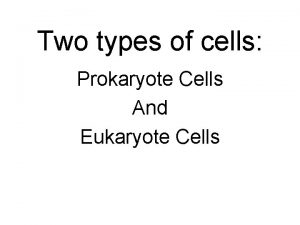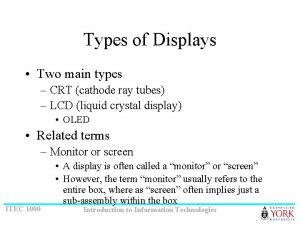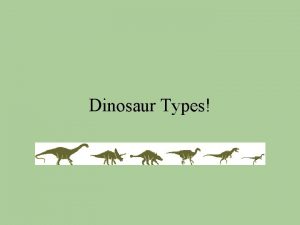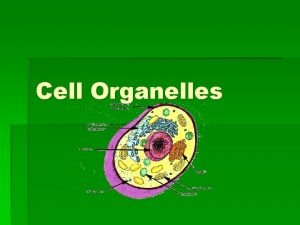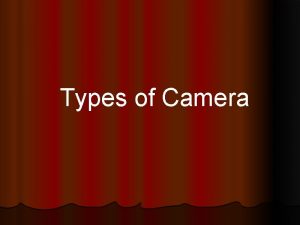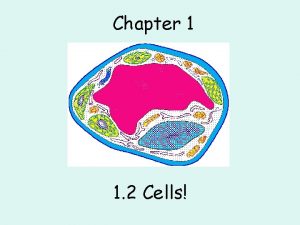CELLS Two main types of cells are and


































- Slides: 34

CELLS Two main types of cells are ______ and _______. A. Prokaryotic; eukaryotic B. Bacterial; animal C. Nerves; muscles D. Plant; animal

The boundary structure that physically defines a cell is the. A. Cell wall B. Selective permeability C. Plasma membrane D. Protein coat © 2009 W. W. Norton & Company, Inc. DISCOVER BIOLOGY 4/e 43

Where is the secreted protein insulin synthesized? A. In the Golgi apparatus B. On the rough ER C. On ribosomes in the cytoplasm D. In the nucleus © 2009 W. W. Norton & Company, Inc. DISCOVER BIOLOGY 4/e 42

Cell Is the Basic Unit of Life n Cell theory: An organism can be one celled or multicellular ¨ Multicellular ¨ Humans n organisms have billions of cells have over 200 types of cells Hooke first described cells in 1665 ¨ Schleiden (1838) recognized plant cells ¨ Schwann (1839) reported animal cells © 2009 W. W. Norton & Company, Inc. DISCOVER BIOLOGY 4/e 2

n cells are too small to be viewed by the naked eye, one way to increase resolution is to increase magnification, such as by using a microscope

6

Cell types n two major types: ¨ Prokaryotic: bacteria and archae n n lacks a nucleus Without a system of internal membranes ¨ Eukaryotic: algae, fungi, plants, animals n n has a nucleus has internal membrane-bound compartments


n Prokaryotes ¨ Little internal organization ¨ Much smaller than eukaryotes © 2009 W. W. Norton & Company, Inc. DISCOVER BIOLOGY 4/e 8

■ Eukaryotes o. DNA contained in nucleus o. Membrane‑enclosed organelles o. Internal compartments for special functions Figure 5. 2 © 2009 W. W. Norton & Company, Inc. DISCOVER BIOLOGY 4/e 9

n Different eukaryotic cells ¨ Protist, fungi, plants= cell wall beyond the plasma membrane ¨ Protist, plants= chloroplasts ¨ Plants= central vacuole ¨ Animals= centrioles

Cell Structure n Cellular structure is organized:

The Plasma Membrane • Defines the boundary of the cell • Consists of a bilayer of lipids with proteins for communication with external environment – Selective permeability – and act as markers= blood types • Fluid mosaic model – Mobility of components of the membrane © 2009 W. W. Norton & Company, Inc. DISCOVER BIOLOGY 4/e 7

© 2009 W. W. Norton & Company, Inc. DISCOVER BIOLOGY 4/e 3

Nucleus: The Administrative Office n n command control center of the cell stores hereditary information: DNA Surrounded by a double-membrane nuclear envelope Nuclear pores are gateways for molecules © 2009 W. W. Norton & Company, Inc. DISCOVER BIOLOGY 4/e 11

n Nucleolus dark-staining region of the nucleus n contains the genes that code for the r. RNA (ribosomal RNA) that makes up the ribosomes n the subunits leave the nucleus via the nuclear pores and the final ribosome is assembled in the cytoplasm n

Mitochondrion: Power Plant n n Double‑membrane organelle Inner membrane folded into cristae Harnesses energy from chemical breakdown Cellular respiration ¨ Produce ATP © 2009 W. W. Norton & Company, Inc. DISCOVER BIOLOGY 4/e 23

Chloroplast: Photosynthesis n n Double‑membrane organelle Contains grana, made of thylakoids Converts CO 2 and H 2 O into sugars using light Chlorophyll enables photosynthesis Figure 5. 10 © 2009 W. W. Norton & Company, Inc. DISCOVER BIOLOGY 4/e 25

The Endoplasmic Reticulum: The Factory Floor n n Interconnected tubes and flattened sacs Rough ER ¨ Ribosomes ¨ Makes membrane and secreted proteins n Figure 5. 4 Smooth ER ¨ Makes membrane vesicles © 2009 W. W. Norton & Company, Inc. DISCOVER BIOLOGY 4/e 13

Golgi: Shipping Department n Stacked, flattened membrane sacs n Processes new proteins and lipids ¨ Adds specific chemical groups ¨ Targets them to their destinations © 2009 W. W. Norton & Company, Inc. DISCOVER BIOLOGY 4/e 17

Vesicles: Movement in the Cell n Vesicles ¨ Membrane‑enclosed n sacs Transport vesicles ¨ Moving substances from one location to another © 2009 W. W. Norton & Company, Inc. DISCOVER BIOLOGY 4/e 15

Lysosomes: Clean-up Crew n n n Small spherical organelles Contain enzymes to break down macromolecules Release simple sugars, amino acids, and fats to be recycled ¨ To ¨ As ¨ To clear cell of damaged organelles a source of food destroy invading bacteria © 2009 W. W. Norton & Company, Inc. DISCOVER BIOLOGY 4/e 19

Peroxisomes: Detoxy centers n n Derivate from membranes in the cell The functions are: 1. 2. detoxify harmful byproducts of metabolism convert fats to carbohydrates in plants seeds for growth

The Central Vacuole: Storage A specialized structure in plants and fungi n Breaks down substances n Stores chemicals for later use Figure 5. 8 n Fills with water to provide rigidity n © 2009 W. W. Norton & Company, Inc. DISCOVER BIOLOGY 4/e 21

Cytoskeleton: microfilament n intermediate filament n n microtubule Gives the cell its shape Provides internal support Is responsible for movement 27

Movement n Used as tracks for vesicle movement or the whole cell © 2009 W. W. Norton & Company, Inc. DISCOVER BIOLOGY 4/e 31

Cilia and Flagella n Cilia beat in unison like oars n Flagella beat like whips © 2009 W. W. Norton & Company, Inc. DISCOVER BIOLOGY 4/e 33

Centrioles • • • complex structures In animal cells and protists Functions: • • anchor locomotory structures assemble microtubules near the nuclear envelope for the cell division

Cell Wall – found in • Plants • Fungi • protists – function in: • Protection • maintaining cell shape • preventing excessive water loss/uptake

Extracellular matrix (ECM) • Outside the plasma membrane • in animal cells • mixture of proteins: Collagen and elastin for protective layer • ECM coordinates cells functioning as tissues

Evolution of Organelles • Eukaryotes most likely evolved from prokaryotes – Larger prokaryotes ingested smaller prokaryotes • Free-living mitochondria and chloroplasts were captured – Formed an endosymbiotic relationship with the host cell © 2009 W. W. Norton & Company, Inc. DISCOVER BIOLOGY 4/e 39

Extra credit…. Make flash cards with all the following terms Cell Chloroplast Chromosome Cilium Ribosome Rough ER Smooth ER Vacuole Vesicle Cytoplasm Cytoskeleton Nuclear envelope Eukaryote Flagellum Nucleolus Fluid mosaic Nucleus model Organelle Golgi apparatus Plasma membrane. Extra cellular matrix Prokaryote Lysosome Mitochondrion peroxysome

Review Question 1: Cell theory includes the principle that A) cells are the smallest living things B) all cells are surrounded by cell walls C) all organisms are made up of many cells D) Nothing smaller than an organelle is considered alive. 2: The plasma membrane is: A) carbohydrate layer that to protect B) double lipid layer with proteins inserted in it C) thin sheet of structural proteins that lines the inside of some body cavities D) composed of blood plasma that has solidified into a protective barrier. 3: Organisms that have cells with cytoplasm and no organelles are called _______, and organisms whose cells have organelles and a nucleus are called _______ A) cellulose, nuclear B) flagellated, streptococcal C) eukaryotes, prokaryotes D) prokaryotes, eukaryotes

4: Within the nucleus of a cell you can find ____ 5: The endomembrane system within a cell includes A) cytoskeleton and ribosomes. B) prokaryotes and eukaryotes C) endoplasmic reticulum and Golgi D) mitochondria and the chloroplasts. 6: Which of the following statements is true? A) All cells have a cell wall for protection and structure. B) Eukaryotic cells in plants and fungi, and all prokaryotes, have a cell wall. C) There is a second membrane composed of structural carbohydrates surrounding all cells. D) Prokaryotes and all cells of eukaryotic animals have a cell wall.
 Insidan region jh
Insidan region jh Two basic types of cells
Two basic types of cells Strepto vs staphylo
Strepto vs staphylo Two types of main idea
Two types of main idea 2 types of plastic
2 types of plastic Linux firewall vs hardware firewall
Linux firewall vs hardware firewall 7 types of drama
7 types of drama Marine ecosystem webquest
Marine ecosystem webquest What are the two main types of glaciers
What are the two main types of glaciers Two main types of dinosaurs
Two main types of dinosaurs Two main types of roots
Two main types of roots Onodi cells and haller cells
Onodi cells and haller cells Chlorocruorin
Chlorocruorin Venn diagram animal and plant cells
Venn diagram animal and plant cells Masses of cells form and steal nutrients from healthy cells
Masses of cells form and steal nutrients from healthy cells Types of main idea
Types of main idea Transport maximum
Transport maximum Parafollicular
Parafollicular Haploid vs diploid venn diagram
Haploid vs diploid venn diagram Why dna is more stable than rna?
Why dna is more stable than rna? Prokaryotic cells vs eukaryotic cells
Prokaryotic cells vs eukaryotic cells Prokaryotes vs eukaryotes venn diagram
Prokaryotes vs eukaryotes venn diagram Why did robert hooke name cells “cells”?
Why did robert hooke name cells “cells”? Pseudostratified vs simple columnar
Pseudostratified vs simple columnar What cell type
What cell type Prokaryotic cell wall
Prokaryotic cell wall Nondisjunction in meiosis
Nondisjunction in meiosis Cells cells they're made of organelles meme
Cells cells they're made of organelles meme Future with will
Future with will Void main int main
Void main int main Human data entry devices
Human data entry devices Four main types of growth and development
Four main types of growth and development Two cells are produced
Two cells are produced What is a haploid cell?
What is a haploid cell? Mitosis diagram
Mitosis diagram

